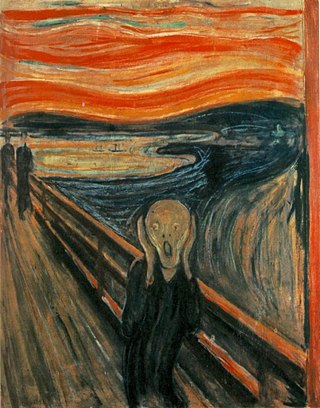
Dissociative fugue, formerly called a fugue state or psychogenic fugue, is a rare psychiatric phenomenon characterized by reversible amnesia for one's identity in conjunction with unexpected wandering or travel. This is sometimes accompanied by the establishment of a new identity and the inability to recall personal information prior to the presentation of symptoms. Dissociative fugue is a mental and behavioral disorder that is classified variously as a dissociative disorder, a conversion disorder, and a somatic symptom disorder. It is a facet of dissociative amnesia, according to the fifth edition of the Diagnostic and Statistical Manual of Mental Disorders (DSM-5).

A phobia is an anxiety disorder, defined by a persistent and excessive fear of an object or situation. Phobias typically result in a rapid onset of fear and are usually present for more than six months. Those affected go to great lengths to avoid the situation or object, to a degree greater than the actual danger posed. If the object or situation cannot be avoided, they experience significant distress. Other symptoms can include fainting, which may occur in blood or injury phobia, and panic attacks, often found in agoraphobia and emetophobia. Around 75% of those with phobias have multiple phobias.
Neurosis is a term mainly used today by followers of Freudian thinking to describe mental disorders caused by past anxiety, often that has been repressed. In recent history, the term has been used to refer to anxiety-related conditions more generally.

Anxiety disorders are a cluster of mental disorders characterized by significant and uncontrollable feelings of anxiety and fear such that a person's social, occupational, and personal functions are significantly impaired. Anxiety may cause physical and cognitive symptoms, such as restlessness, irritability, easy fatigue, difficulty concentrating, increased heart rate, chest pain, abdominal pain, and a variety of other symptoms that may vary based on the individual.

Agoraphobia is a mental and behavioral disorder, specifically an anxiety disorder characterized by symptoms of anxiety in situations where the person perceives their environment to be unsafe with no easy way to escape. These situations can include public transit, shopping centers, crowds and queues, or simply being outside their home on their own. Being in these situations may result in a panic attack. Those affected will go to great lengths to avoid these situations. In severe cases, people may become completely unable to leave their homes.

Clarice M. Starling is a fictional character and protagonist of the novels The Silence of the Lambs (1988) and Hannibal (1999) by Thomas Harris.
Selective mutism (SM) is an anxiety disorder in which a person who is otherwise capable of speech becomes unable to speak when exposed to specific situations, specific places, or to specific people, one or multiple of which serving as triggers. This is caused by the freeze response. Selective mutism usually co-exists with social anxiety disorder. People with selective mutism stay silent even when the consequences of their silence include shame, social ostracism, or punishment.

In psychology, emotional detachment, also known as emotional blunting, is a condition or state in which a person lacks emotional connectivity to others, whether due to an unwanted circumstance or as a positive means to cope with anxiety. Such a coping strategy, also known as emotion focused-coping, is used when avoiding certain situations that might trigger anxiety. It refers to the evasion of emotional connections. Emotional detachment may be a temporary reaction to a stressful situation, or a chronic condition such as depersonalization-derealization disorder. It may also be caused by certain antidepressants. Emotional blunting, also known as reduced affect display, is one of the negative symptoms of schizophrenia.

Hannibal is a psychological horror novel by American author Thomas Harris, published in 1999. It is the third in his series featuring Dr. Hannibal Lecter and the second to feature FBI Special Agent Clarice Starling. The novel takes place seven years after the events of The Silence of the Lambs and deals with the intended revenge of one of Lecter's victims. It was adapted as a film of the same name in 2001, directed by Ridley Scott. Elements of the novel were incorporated into the second season of the NBC television series Hannibal, while the show's third season adapted the plot of the novel.

One Child is a memoir by American author and psychologist Torey Hayden. It was first published in the United States in 1980, becoming a bestseller in the 2000s. The book has been translated into 27 languages and dramatized as an interactive opera. It was also loosely adapted as the 1994 Lifetime television film Untamed Love, starring Ashlee Lauren, Lois Foraker and Cathy Lee Crosby. The book has inspired people to move into Special Educational Need careers.
In human development, muteness or mutism is defined as an absence of speech, with or without an ability to hear the speech of others. Mutism is typically understood as a person's inability to speak, and commonly observed by their family members, caregivers, teachers, doctors or speech and language pathologists. It may not be a permanent condition, as muteness can be caused or manifest due to several different phenomena, such as physiological injury, illness, medical side effects, psychological trauma, developmental disorders, or neurological disorders. A specific physical disability or communication disorder can be more easily diagnosed. Loss of previously normal speech (aphasia) can be due to accidents, disease, or surgical complication; it is rarely for psychological reasons.
Social anxiety is the anxiety and fear specifically linked to being in social settings. Some categories of disorders associated with social anxiety include anxiety disorders, mood disorders, autism spectrum disorders, eating disorders, and substance use disorders. Individuals with higher levels of social anxiety often avert their gazes, show fewer facial expressions, and show difficulty with initiating and maintaining a conversation. Social anxiety commonly manifests itself in the teenage years and can be persistent throughout life; however, people who experience problems in their daily functioning for an extended period of time can develop social anxiety disorder. Trait social anxiety, the stable tendency to experience this anxiety, can be distinguished from state anxiety, the momentary response to a particular social stimulus. Half of the individuals with any social fears meet the criteria for social anxiety disorder. Age, culture, and gender impact the severity of this disorder. The function of social anxiety is to increase arousal and attention to social interactions, inhibit unwanted social behavior, and motivate preparation for future social situations.

Rajesh "Raj" Ramayan Koothrappali, PhD is a fictional character on the CBS television series The Big Bang Theory, portrayed by Indian actor Kunal Nayyar. He is one of four main male characters in the show, alongside Howard Wolowitz, Sheldon Cooper, and Leonard Hofstadter, to appear in every episode of The Big Bang Theory. Raj is based on a computer programmer that the show's co-creator, Bill Prady, knew when he was a programmer.
Mental disorders diagnosed in childhood can be neurodevelopmental, emotional, or behavioral disorders. These disorders negatively impact the mental and social wellbeing of a child, and children with these disorders require support from their families and schools. Childhood mental disorders often persist into adulthood. These disorders are usually first diagnosed in infancy, childhood, or adolescence, as laid out in the DSM-5 and in the ICD-11.

Social anxiety disorder (SAD), also known as social phobia, is an anxiety disorder characterized by sentiments of fear and anxiety in social situations, causing considerable distress and impairing ability to function in at least some aspects of daily life. These fears can be triggered by perceived or actual scrutiny from others. Individuals with social anxiety disorder fear negative evaluations from other people.
Folie à deux, also known as shared psychosis or shared delusional disorder (SDD), is a rare psychiatric syndrome in which symptoms of a delusional belief, and sometimes hallucinations, are "transmitted" from one individual to another.
Trapped in Silence is a 1986 American made-for-television drama film starring Kiefer Sutherland and Marsha Mason, produced by Dick Atkins and Jeff Grant for Reader's Digest Entertainment Inc. It is based on the book Murphy's Boy by Torey Hayden.
Thought blocking is a neuropsychological symptom expressing a sudden and involuntary silence within a speech, and eventually an abrupt switch to another topic. Persons undergoing thought blocking may utter incomprehensible speech; they may also repeat words involuntarily or make up new words. The main causes of thought blocking are schizophrenia, anxiety disorders, petit mal seizures, post-traumatic stress disorder, bradyphrenia, aphasia, dementia and delirium.
Autophobia, also called monophobia, isolophobia, or eremophobia, is the specific phobia or a morbid fear or dread of oneself or of being alone, isolated, abandoned, and ignored. This specific phobia is associated with the idea of being alone, often causing severe anxiety.
Social Phobia and Anxiety Inventory Brief, abbreviated as (SPAI-B), is a Spanish version of the Social Phobia and Anxiety Inventory. It evaluates the same psychological factors as SPAI related to cognition, behavior and somatic symptoms usually exhibited by persons with social anxiety. Although the psychometrics have been found to be sound, its utility as a screening measure is limited by its length. As an attempt to resolve this situation, Deborah Beidel from University of Central Florida (US), along with an international team led by Dr. Garcia-Lopez at the University of Jaen (Spain) developed this form in 2008.









